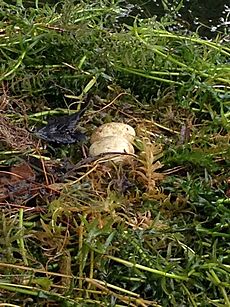Pied-billed grebe facts for kids
Quick facts for kids Pied-billed grebe |
|
|---|---|
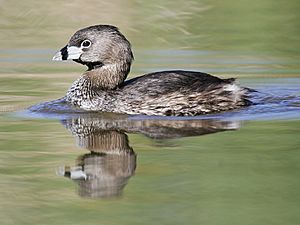 |
|
| P. p. podiceps, Summer plumage | |
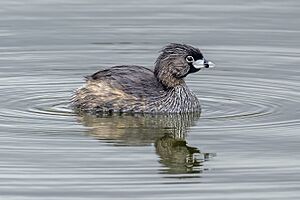 |
|
| P. p. antarcticus, Colombia | |
| Conservation status | |
| Scientific classification | |
| Genus: |
Podilymbus
|
| Species: |
podiceps
|
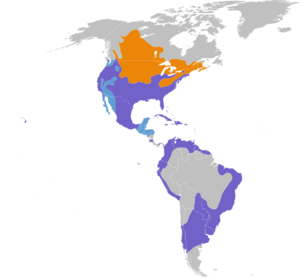 |
|
| Approximate distribution map
Breeding Year-round Nonbreeding |
|
| Synonyms | |
|
Colymbus podiceps Linnaeus, 1758 |
|
The pied-billed grebe (Podilymbus podiceps) is a type of water bird. It belongs to the grebe family. You can mostly find these birds in ponds across the Americas.
Contents
About the Pied-Billed Grebe
The pied-billed grebe got its scientific name from Carl Linnaeus in 1758. He was a famous scientist. The name Podilymbus comes from Latin words meaning "feet at the rump." This describes where their feet are placed on their body. The word podiceps means "rump-headed."
Other Names for This Bird
People have given this grebe many other names. Some common ones include American dabchick and hell-diver. It is also called water witch and thick-billed grebe.
Grebe Family Tree
The pied-billed grebe is the only living member of its group, called Podilymbus. Another grebe, the Atitlán grebe, used to be in this group but is now extinct. The pied-billed grebe's closest relatives are the small grebes in the group Tachybaptus.
Different Types of Pied-Billed Grebes
There are three main types, or subspecies, of the pied-billed grebe:
- P. p. podiceps: This type lives in North America, from Canada down to Panama.
- P. p. antarcticus: This type is found in South America. It lives from Colombia to central Chile and Argentina.
- P. p. antillarum: This type lives on the islands of the Greater and Lesser Antilles.
What Does a Pied-Billed Grebe Look Like?
Pied-billed grebes are small birds. They have a stocky body and a short neck. They are about 31–38 cm (12–15 in) long. Their wings can spread up to 45–62 cm (18–24 in) wide. They weigh between 253–568 g (8.9–20.0 oz).
These birds are mostly brown. Their head and back are a darker brown. This brown color helps them hide in the marshy places where they live. When they fly, you won't see white under their wings like with some other grebes. Their tail feathers are white.
They have a short, blunt bill that looks a bit like a chicken's bill. It is light grey. In summer, their bill has a wide black band around it. This is how they got the name "pied-billed." In summer, their throat also turns black. Male and female grebes look the same. Young grebes have black and white stripes. They look more like adult grebes in winter.
Special Feet for Swimming
Pied-billed grebes do not have webbed feet like ducks. Instead, their toes have special flaps, called lobes. These lobes stick out from the side of each toe. They help the grebe paddle easily in the water. Because their feet are placed far back on their body, they are not good at walking on land. When they fly, their feet stick out behind them.
Spotting the Difference
Sometimes, people might confuse pied-billed grebes with other birds.
- They are smaller than most ducks. Grebes also have a different bill shape. Their bills are shorter, pointed, and flat on the sides. Ducks have longer necks and bodies.
- The least grebe is much smaller and has a thinner bill.
- Other grebes, like the eared grebe and horned grebe, look very different. They have bright colors in breeding season. They have golden crests and red eyes.
Did you know? The closest living relatives of grebes are flamingos!
What Do They Sound Like?
The pied-billed grebe has a special, loud call. It sounds like "whooping kuk-kuk-cow-cow-cow-cowp-cowp." It can sound a bit like the yellow-billed cuckoo.
Where Do Pied-Billed Grebes Live?
You can find pied-billed grebes all year round in North, Central America, the Caribbean, and South America. During the summer, when they have babies, they are common in central and northern Canada.
If the water freezes where they live, they will fly to warmer places for the winter. These birds usually migrate at night. They travel south in September and October. They return north in March or April. Sometimes, they are seen in Europe and Hawaii, but this is rare. One grebe in England even had babies with a little grebe. The pied-billed grebe is the only grebe ever seen in the Galapagos Islands.
Their Home Environment
Pied-billed grebes prefer freshwater wetlands. These are places with plants growing out of the water, like cattails. Sometimes, they are found in salt water. When they are breeding, they stay near these plants and open water. In winter, they mostly stay in open water because they don't have nests to take care of. They like still water more than rivers. They can also live in wetlands that humans have built or fixed up.
Pied-billed grebes usually live for about 10 to 12 years.
Pied-Billed Grebe Behavior
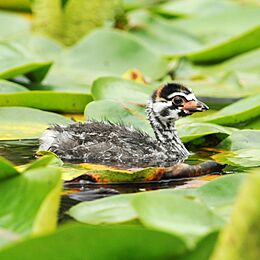
Pied-billed grebes do not fly very often. They are known for diving underwater. They dive especially when they feel unsafe. They can dive about 20 ft (6.1 m) deep or less. They stay underwater for about 30 seconds. They might swim to a hidden part of the water. Sometimes, only their head will pop up to watch for danger. Because they dive so often, people think they are shy birds. This is why they are sometimes called "hell-divers."
Grebes can trap air in their feathers. This helps them control how much they float. They usually do not stay in large groups. When they are trying to find a mate, they will call out. Sometimes, a male and female will call together. If another male comes too close to a male's area, they will act territorial. They face each other, then turn their heads up, call, and turn away. Then they turn back to look at each other.
Reproduction and Life Cycle
Pied-billed grebes have their babies in south-central Canada, across the United States, Central America, the Caribbean, and warmer parts of South America. They can lay eggs up to two times a year.
Their nests float on top of the water. The eggs sit in plants that grow in the water. Grebes lay between three and ten smooth, bluish-white eggs. The female starts sitting on the eggs first. Both parents take turns incubating the eggs for about 23 days. The female usually finishes the incubation. If they leave the nest, they cover the eggs with nesting material to protect them.
Raising the Young
Young grebes can leave the nest within a day of hatching. They are covered in soft downy feathers. They have yellow skin between their eyes and the top of their head. They are not good swimmers at first. They often sleep on their parents' backs. After about four weeks, they start swimming. When they feel scared, they will climb onto a parent's back. Eventually, they learn to dive underwater like their parents. Both parents help raise the young. They both feed them and carry them on their backs. Sometimes, parents will even dive underwater to get food with the chicks still on their backs!
What Do Pied-Billed Grebes Eat?
Pied-billed grebes mostly eat small water animals without backbones, like insects. They also eat small fish and amphibians, such as frogs and tadpoles. They dive underwater to catch their food. Their strong bills help them crush crustaceans, like crawfish. They might also eat plants. Like other grebes, they have been seen eating their own feathers. This helps them digest their food and protects their stomachs from small bones. They also feed feathers to their young.
Dangers to Pied-Billed Grebes
Pied-billed grebes are very sensitive to being disturbed, especially by humans. If adults get scared while breeding, they might leave their nests without protecting the eggs. Waves from boats can destroy their nests. Loud boat sounds can also easily frighten the birds.
Pied-Billed Grebes in History
Pied-billed grebe feathers are thick and soft. In the 1800s, people used their feathers to decorate hats and earmuffs. Because of this, they were hunted in the eastern United States.
Current Status of the Grebe
The number of pied-billed grebes is decreasing in the Northeastern United States. The reasons for this are not fully known. Some states have declared them endangered, like Connecticut and New Hampshire. In New Jersey and Massachusetts, they are considered threatened. In Vermont, they are of "special concern." In Rhode Island, they have disappeared completely from the state. Pied-billed grebes are protected by the Migratory Bird Treaty Act of 1918.
The biggest danger to grebes is losing their homes. When wetlands are drained, filled in, or destroyed, grebes lose places to have their babies. However, they are still common in most other areas where they live.



